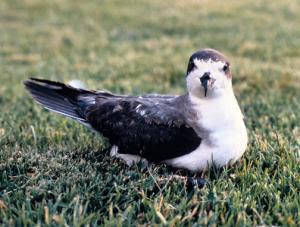HILO — For the first time in more than 50 years, the sound of the uau, or Hawaiian petrel (Pterodroma sandwichensis), was heard on Maunakea, thanks to research funded by the University of Hawaii Office of Maunakea Management and the hard work of the UH Hilo Listening Observatory for Hawaiian Ecosystems Bioacoustics Lab.
The uau forage at sea and fly inland after sunset to build underground nests in higher elevation areas throughout the Hawaiian Islands, including Kauai, Haleakala on Maui, Maunaloa on Hawaii Island and Lanaihale on Lanai.
They are a state and federally listed endangered species and are highly susceptible to introduced predators such as cats and mongoose when they are nesting.
“Finding uau on Maunakea has been a very challenging and rewarding experience,” said UH Hilo graduate student Bret Nainoa Mossman, who along with UH Hilo researcher Patrick Hart, has been looking and listening for the seabirds and opeapea, or Hawaiian hoary bats, at high elevations on Maunakea. “For me, it is a feeling of relief and hope to know that the uau of Maunakea have been able to survive despite all of the challenges they face and it is heartening to know that this species is still here for future generations to see and appreciate.”
The uau has been detected acoustically since 2018 at many locations near Maunakea’s Puukanakaleonui. In addition, a dead uau was recently found in the forest reserve above Puukanakaleonui on the eastern slope of Red Hill. Rediscovering uau on Maunakea indicates the species likely continues to use the mountain as a nesting site.

